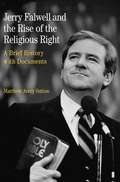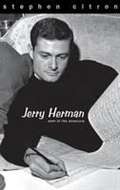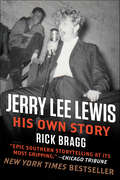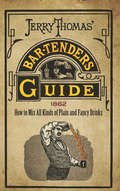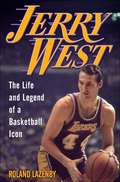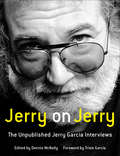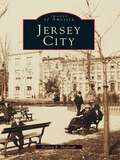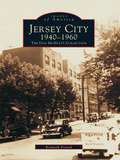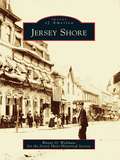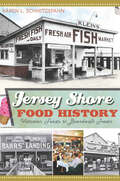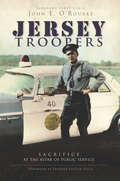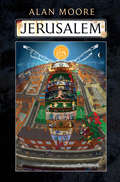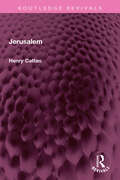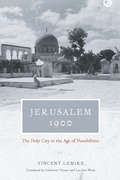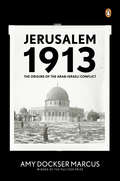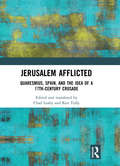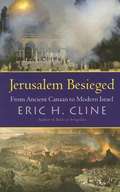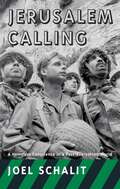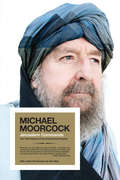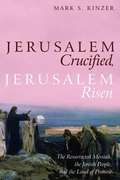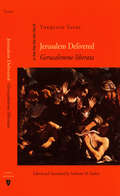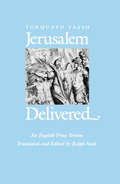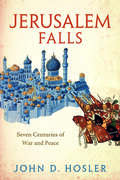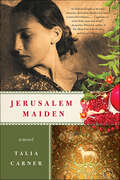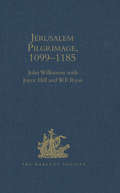- Table View
- List View
Jerry Falwell and the Rise of the Religious Right: A Brief History With Documents
by Matthew Avery SuttonAs one of the most media-savvy ministers in U.S. history, Jerry Falwell figured prominently in the political mobilization of religious conservatives in the 1970s and early 1980s. Falwell’s life and work touched on almost all of the major issues of the time period: the cold war, changing gender roles, civil rights, the revitalization of American conservatism, and the Reagan revolution. <P><P> In his introductory essay, Matthew Avery Sutton traces Falwell’s politicization and rise to celebrity status, using Falwell as a lens through which to view the larger movement. More than two dozen primary documents focus on the Religious Right’s emergence in the 1970s as a powerful political force and present students with first-hand accounts of the era’s culture wars. <P><P>The thematically arranged documents – including sermons, letters, speeches, interviews, court documents, and children’s books – provide an up-close look at the motivations and aspirations of the Religious Right. Photographs, document headnotes, a chronology, questions for consideration, and a selected bibliography provide additional pedagogical support.
Jerry Herman: Poet of the Showtune
by Stephen CitronThis revealing and comprehensive book tells the full story of Jerry Herman's life and career, from his early work in cabaret to his recent compositions for stage, screen, and television. Stephen Citron draws on extensive open-ended interviews with Jerry Herman as well as with scores of his theatrical colleagues, collaborators, and close friends. The resulting book--which sheds new light on each of Herman's musicals and their scores--abounds in fascinating anecdotes and behind-the-scenes details about the world of musical theater. Readers will find a sharply drawn portrait of Herman's private life and his creative talents. Citron's insights into Herman's music and lyrics, including voluminous examples from each of his musicals, are as instructive as they are edifying and entertaining.
Jerry Lee Lewis: His Own Story
by Rick BraggThe greatest Southern storyteller of our time tracks down the greatest rock and roller of all time—and gets his own story, from the source, for the very first time.The New York Times BestsellerOne of Rolling Stone’s 10 Best Music Books of the YearA monumental figure on the American landscape, Jerry Lee Lewis spent his childhood raising hell in Ferriday, Louisiana, and Natchez, Mississippi; galvanized the world with hit records like “Whole Lotta Shakin’ Goin’ On” and “Great Balls of Fire,” that gave rock and roll its devil’s edge; caused riots and boycotts with his incendiary performances; nearly scuttled his career by marrying his thirteen-year-old second cousin—his third wife of seven; ran a decades-long marathon of drugs, drinking, and women; nearly met his maker, twice; suffered the deaths of two sons and two wives, and the indignity of an IRS raid that left him with nothing but the broken-down piano he started with; performed with everyone from Elvis Presley to Keith Richards to Bruce Springsteen to Kid Rock—and survived it all to be hailed as “one of the most creative and important figures in American popular culture and a paradigm of the Southern experience.”Jerry Lee Lewis: His Own Story is the Killer’s life as he lived it, and as he shared it over two years with our greatest bard of Southern life: Rick Bragg. Rich with Lewis’s own words, framed by Bragg’s richly atmospheric narrative, this is the last great untold rock-and-roll story, come to life on the page.“An enthralling look at the birth of rock & roll and the ensuing life of its arguably most colorful exponent.” —Entertainment Weekly
Jerry Thomas' Bartenders Guide: How To Mix All Kinds Of Plain And Fancy Drinks
by Jerry ThomasCare for a Morning Glory Cocktail, a Blue Blazer, or a Philadelphia Julep? Recipes for these and hundreds of other tasty libations appear in this landmark volume. Originally published in 1862, Jerry Thomas' Bartenders Guide is widely considered by drink historians as the first serious American book on cocktails and punches. "A new beverage is the pride of the bartender, and its appreciation and adoption his crowning glory," declared Jerry Thomas (1830–85), the most famous bartender of his era. Known as "the father of American mixology," Thomas developed the showy techniques practiced at his saloons throughout California and New York. From hot whiskey toddies to wedding punch to "temperance drinks," this extensive compilation of timeless recipes will delight modern-day mixologists and their guests. "There are so many bartending recipes in this book, it's doubtful you'll need any other guide." — The Paperback Stash.
Jerry West: The Life and Legend of a Basketball Icon
by Roland LazenbyWhen in 1969 the NBA sought an emblem for the league, one man was chosen above all as the icon of his sport: Jerry West. Silhouetted in white against a red-and-blue backdrop, West’s signature gait and left-handed dribble are still the NBA logo, seen on merchandise around the world. In this marvelous book—the first biography of the basketball legend—award-winning reporter and author Roland Lazenby traces Jerry West’s brilliant career from the coalfields near Cabin Creek, West Virginia, to the bare-knuckled pre-expansion era of the NBA, from the Lakers’ Riley-Magic-Kareem Showtime era to Jackson–Kobe–Shaq teams of the early twenty-first century, and beyond. But fame was not all glory. Called “Mr. Clutch,” West was an incomparable talent—flawless on defense, possessing unmatched court vision, and the perfect jumper, unstoppable when the game was on the line. Beloved and respected by fans and fellow players alike, West was the centerpiece of Lakers teams that starred such players as Elgin Baylor and Wilt Chamberlain, and he went on to nine NBA Finals. Yet in losing eight of those series, including six in a row to the detested Boston Celtics, West became as famous for his failures as for his triumphs. And that notoriety cast long shadows over West’s life on and off the court.
Jerry on Jerry: The Unpublished Jerry Garcia Interviews
by Dennis Mcnally Trixie GarciaListen in on hours of revelatory conversations with Jerry Garcia, one of the most beloved and missed figures in the world of music, with JERRY ON JERRY. More than twenty years after his death, at too young an age, Jerry remains a cultural icon whose influence and legacy endure. Now, these never-before-heard interviews reveal a candid and poignant side of Jerry, as he speaks openly on everything from religion and politics to his personal life and his creative process. Carefully selected by former Grateful Dead publicist and the band's authorized biographer, Dennis McNally, and curated with the cooperation of the Jerry Garcia Family, JERRY ON JERRY marks the first time these insightful and intimate archival recordings have ever been made available to the public.Here, Garcia talks about what it was like growing up in the San Francisco Bay Area, his obsession with his first guitar, and his first encounters with early R&B, which had a profound and lasting impact on his music. After discussing his brief, but eye-opening stint in the army, Jerry offers up stories of his time spent as a student of the Beats, and his personal and reverent memories of Neal Cassady. He ponders what he sees as the complicated nature of LSD and the oppressiveness of government. He goes on to remember in detail the early days of the Dead, from their first gigs as the Warlocks and their days at 710 Ashbury Street, to the Monterey Pop Festival in 1967 and performing on the road with Jefferson Airplane. Throughout he breaks to opine on movies (one of his favorite subjects), to open up about his songwriting process and his prolific collaboration with Robert Hunter, and his admiration for a broad range of musicians from the Rolling Stones and Bob Dylan to Scotty Stoneman and Bill Keith. Dozens of rare family photographs, and other art and ephemera, many of which have never been seen before, are included here in a PDF. With an introduction written and read by Dennis McNally, and a foreword written and read by Trixie Garcia, Jerry's daughter, this audiobook is the ultimate complement to any collection. JERRY ON JERRY is one of the most revealing and unguarded portraits of the adored front man of the Grateful Dead and a true, long-awaited gift to his fans.
Jersey City (Images of America)
by Patrick B. ShalhoubPatrick Shalhoub has brought together over two hundred fascinating photographs and prints of Jersey City which bring to life the people, places, and events which have created the city's vibrant and colorful history over the centuries. He takes us on a journey into the past. We see the farming communities which dominated the locality from the 1660s through the middle of the nineteenth century, when the area was part of the larger Bergen Township. We then experience the arrival of the immigrants, the advent of industrialization, and the rapid growth of Jersey City from a cluster of farmsteads and villages into the second largest city in New Jersey. Immigration has been the lifeblood of Jersey City's history, and through the images selected here we witness how Jersey City sprang to life with the influx of immigrants between 1830 and 1920-at first, Irish, German, and British, and, later, immigrants from southern and eastern Europe, including Italians, Poles, Russians, and Slovaks. African-Americans were present in Bergen Township from the early days of the city, but their numbers increased with the migration of laborers from the South in the first half of the twentieth century and their important contribution to the city continued. In recent decades, new communities have grown in Jersey City, including Latin American, Asian Indian, Egyptian, Filipino, and Haitian communities.
Jersey City 1940-1960: The Dan McNulty Collection
by Kenneth FrenchPhotographer Dan McNulty was a Jersey City resident who spent most of his time working in his family's funeral home. McNulty's photography was a mere sideline, but this fact did not affect the high artistic quality of the images of the city that he produced during the 1940s and '50s. During the two decades of McNulty's work, Jersey City experienced many changes. The powerful political machine of Mayor Frank Hague was brought down after thirty yearsin 1949 by the reform team of John V. Kenny, and this period also saw the end of the city's success in the railroad industry. In the 1950s, the first large housing projects were constructed in the city; other sweeping developments in this sphere would follow in the 1960s. McNulty documented these changes and others that resulted during this twenty year period through dramatic photographs of vacant railroad terminals, dynamic commercial and residential districts, successful factories and manufacturing plants, and significant WPA projects such as the Jersey City Medical Center and Roosevelt Stadium.
Jersey Shore
by Wayne O. Welshans Jersey Shore Historical SocietyJersey Shore, a small town with a seemingly misplaced name, was on the edge of the western frontier during Revolutionary War days, and those who settled in this area prior to 1784 found themselves outside the jurisdiction of both Great Britain and the commonwealth. Out of this was produced a Fair Play society, the Pine Creek Declaration of Independence, and something known as the Big Runaway. By 1800, a little village began to form along the banks of the west branch of the Susquehanna River. Over time, the West Branch Canal, lumbering, and a very large New York Central Railroad shop brought growth and prosperity to the area. Jersey Shore presents a visual story of the area through pictures taken by local photographers, including Joseph Mick, William H. Garman, and Jonathan Potter, dating from Civil War days to around 1930.
Jersey Shore Food History: Victorian Feasts to Boardwalk Treats (American Palate Ser.)
by Karen L Schnitzphan&“Chock full of photographs, the book dishes on food from the mid-1800s to the mid-1900s, all along the coast from Sandy Hook to Cape May.&” —RedBankGreen No trip to the Jersey Shore would be complete without indulging in the cuisine that helps make it famous. These foods we enjoy today are part of a long tradition beginning in the Victorian era, when big oceanfront hotels served elaborate meals. Diverse dishes and restaurants emerged during prohibition and the Great Depression, when fast food appeared and iconic boardwalk treats developed. Predating the farm to table movement, fancy and fast eateries have been supplied by local fishermen and farmers for decades. So whether you indulge in a tomato pie, pork roll or salt water taffy, take a mouthwatering historical tour and discover timeless treats from Sandy Hook to Cape May. &“Tells the story of the original farm and sea to table American destination. The book is filled with information about the way the NJ shore has eaten through history and the food establishments that have spanned generations, some still operating today.&” —NJ.com &“This book also gives us insights into the earliest days of Atlantic City&’s fine hotels. The Victorian era menus included in the volume are a treasure. I also loved her inclusion of such iconic former restaurants as Hackney&’s and Capt. Starn&’s and the still standing Knife and Fork Inn.&” —Atlantic City Central &“If you enjoy walking the Boardwalk for your pork roll and salt water taffy fix, or if you appreciate the history of the region&’s former great restaurants like Hackney&’s, Capt. Starn&’s and Zaberer&’s, this book will be an entertaining read.&” —Atlantic City Weekly
Jersey Troopers: Sacrifice at the Altar of Public Service
by Sergeant First O'Rourke Trooper Eliecer AyalaThe New Jersey State Police is an organization rich in history and tradition. Formed in 1921, the "outfit" has grown from a rural police force into one of the most diversified state agencies in the country. Sadly, this success did not come without a price; over thirty-five troopers gave their lives serving the citizens of the Garden State during the organization's formative years, from 1921 to 1960. This book honors their memory, telling the stories of these brave men, and upholds the state police's credo: It is the obligation--the Duty--of the living to remember--Honor--the dead. Let us always remember--Fidelity.
Jerusalem
by Alan MooreFierce in its imagining and stupefying in its scope, Jerusalem is the tale of everything, told from a vanished gutter. In the epic novel Jerusalem, Alan Moore channels both the ecstatic visions of William Blake and the theoretical physics of Albert Einstein through the hardscrabble streets and alleys of his hometown of Northampton, UK. In the half a square mile of decay and demolition that was England's Saxon capital, eternity is loitering between the firetrap housing projects. Embedded in the grubby amber of the district's narrative among its saints, kings, prostitutes, and derelicts, a different kind of human time is happening, a soiled simultaneity that does not differentiate between the petrol-colored puddles and the fractured dreams of those who navigate them. Employing, a kaleidoscope of literary forms and styles that ranges from brutal social realism to extravagant children's fantasy, from the modern stage drama to the extremes of science fiction, Jerusalem's dizzyingly rich cast of characters includes the living, the dead, the celestial, and the infernal in an intricately woven tapestry that presents a vision of an absolute and timeless human reality in all of its exquisite, comical, and heartbreaking splendor. In these pages lurk demons from the second-century Book of Tobit and angels with golden blood who reduce fate to a snooker tournament. Vagrants, prostitutes, and ghosts rub shoulders with Oliver Cromwell, Samuel Beckett, James Joyce's tragic daughter Lucia, and Buffalo Bill, among many others. There is a conversation in the thunderstruck dome of St. Paul's Cathedral, childbirth on the cobblestones of Lambeth Walk, an estranged couple sitting all night on the cold steps of a Gothic church front, and an infant choking on a cough drop for eleven chapters. An art exhibition is in preparation, and above the world a naked old man and a beautiful dead baby race along the Attics of the Breath toward the heat death of the universe. An opulent mythology for those without a pot to piss in, through the labyrinthine streets and pages of Jerusalem tread ghosts that sing of wealth, poverty, and our threadbare millennium. They discuss English as a visionary language from John Bunyan to James Joyce, hold forth on the illusion of mortality post-Einstein, and insist upon the meanest slum as Blake's eternal holy city.
Jerusalem (Routledge Revivals)
by Henry CattanFirst published in 1981, Jerusalem provides an overview of the history of Jerusalem and its crucial linkage with the peace and stability in the Middle East. Jerusalem is unique amongst all the cities of the world because of its association with three great religions. It is the spiritual and religious heritage to one half of humanity and is holy for millions of Christians, Jews, and Muslims. All three religion have a vital interest in preserving in addition to their Holy places and sanctuaries, the living presence of the adherents to their faith in the Holy City. When the Zionist movement was formed at the end of the last century, the idea of a Jewish State was conceived as an answer to anti-semitism, and the movement initially considered other countries for settlement because Jerusalem was seen as a spiritual rather than a secular home to the Jewish people. Yet since the creation of the state of Israel in 1948, Zionism has claimed Jerusalem as its own. It is obvious that neither the Palestinians, not the Arabs, nor Islam and Christianity will acquiesce in Israeli domination. This book argues that the continuation of Zionism in its present form is likely to prove perilous to peace and stability in the region. This book is an important historical read for students and scholars of Middle East studies and Middle East history.
Jerusalem 1900: The Holy City in the Age of Possibilities
by Catherine Tihanyi Lys Ann Weiss Vincent LemirePerhaps the most contested patch of earth in the world, Jerusalem’s Old City experiences consistent violent unrest between Israeli and Palestinian residents, with seemingly no end in sight. Today, Jerusalem’s endless cycle of riots and arrests appears intractable—even unavoidable—and it looks unlikely that harmony will ever be achieved in the city. But with Jerusalem 1900, historian Vincent Lemire shows us that it wasn’t always that way, undoing the familiar notion of Jerusalem as a lost cause and revealing a unique moment in history when a more peaceful future seemed possible. In this masterly history, Lemire uses newly opened archives to explore how Jerusalem’s elite residents of differing faiths cooperated through an intercommunity municipal council they created in the mid-1860s to administer the affairs of all inhabitants and improve their shared city. These residents embraced a spirit of modern urbanism and cultivated a civic identity that transcended religion and reflected the relatively secular and cosmopolitan way of life of Jerusalem at the time. These few years would turn out to be a tipping point in the city’s history—a pivotal moment when the horizon of possibility was still open, before the council broke up in 1934, under British rule, into separate Jewish and Arab factions. Uncovering this often overlooked diplomatic period, Lemire reveals that the struggle over Jerusalem was not historically inevitable—and therefore is not necessarily intractable. Jerusalem 1900 sheds light on how the Holy City once functioned peacefully and illustrates how it might one day do so again.
Jerusalem 1913
by Marcus Amy DockserSearching for the origins of the Arab-Israeli conflict, historians for years focused on the British Mandate period (1920-1948). Amy Dockser Marcus, however, demonstrates that the bloody struggle for power actually started much earlier, when Jerusalem was still part of the Ottoman Empire and the rise of Zionism and Arab nationalism laid the groundwork for the battles that would continue to rage nearly a century later.
Jerusalem Afflicted: Quaresmius, Spain, and the Idea of a 17th-century Crusade
by Chad Leahy Ken TullyOn Good Friday, 1626, Franciscus Quaresmius delivered a sermon in the Church of the Holy Sepulcher in Jerusalem calling on King Philip IV of Spain to undertake a crusade to ‘liberate’ the Holy Land. Jerusalem Afflicted: Quaresmius, Spain, and the Idea of a 17th-century Crusade introduces readers to this unique call to arms with the first-ever edition of the work since its publication in 1631. Aside from an annotated English translation of the sermon, this book also includes a series of introductory chapters providing historical context and textual commentary, followed by an anthology of Spanish crusading texts that testify to the persistence of the idea of crusade throughout the 17th century. Quaresmius’ impassioned and thoroughly reasoned plea is expressed through the voice of Jerusalem herself, personified as a woman in bondage. The friar draws on many of the same rhetorical traditions and theological assumptions that first launched the crusading movement at Clermont in 1095, while also bending those traditions to meet the unique concerns of 17th-century geopolitics in Europe and the Mediterranean. Quaresmius depicts the rescue of the Holy City from Turkish abuse as a just and necessary cause. Perhaps more unexpectedly, he also presents Jerusalem as sovereign Spanish territory, boldly calling on Philip as King of Jerusalem and Patron of the Holy Places to embrace his royal duty and reclaim what is rightly his on behalf of the universal faithful. Quaresmius’ early modern call to crusade ultimately helps us rethink the popular assumption that, like the chivalry imagined by Don Quixote, the crusades somehow died along with the middle ages.
Jerusalem Besieged: From Ancient Canaan to Modern Israel
by Eric H. Cline"Jerusalem Besieged is a fascinating account of how and why a baffling array of peoples, ideologies, and religions have fought for some four thousand years over a city without either great wealth, size, or strategic importance. Cline guides us through the baffling, but always bloody, array of Jewish, Roman, Moslem, Crusader, Ottoman, Western, Arab, and Israeli fights for possession of such a symbolic prize in a manner that is both scholarly and engaging. " -Victor Davis Hanson, Stanford University; author ofThe Other GreeksandCarnage and Culture "A beautifully lucid presentation of four thousand years of history in a single volume. Cline writes primarily as an archaeologist-avoiding polemic and offering evidence for any religious claims-yet he has also incorporated much journalistic material into this study. Jerusalem Besieged will enlighten anyone interested in the history of military conflict in and around Jerusalem. " -Col. Rose Mary Sheldon, Virginia Military Institute "This groundbreaking study offers a fascinating synthesis of Jerusalem's military history from its first occupation into the modern era. Cline amply deploys primary source material to investigate assaults on Jerusalem of every sort, starting at the dawn of recorded history. Jerusalem Besieged is invaluable for framing the contemporary situation in the Middle East in the context of a very long and pertinent history. " -Baruch Halpern, Pennsylvania State University A sweeping history of four thousand years of struggle for control of one city "[An] absorbing account of archaeological history, from the ancient Israelites' first conquest to today's second intifada. Cline clearly lays out the fascinating history behind the conflicts. " -USA Today "A pleasure to read, this work makes this important but complicated subject fascinating. " -Jewish Book World "Jerusalem Besieged is a fascinating account of how and why a baffling array of peoples, ideologies, and religions have fought for some four thousand years over a city without either great wealth, size, or strategic importance. Cline guides us through the baffling, but always bloody, array of Jewish, Roman, Moslem, Crusader, Ottoman, Western, Arab, and Israeli fights for possession of such a symbolic prize in a manner that is both scholarly and engaging. " -Victor Davis Hanson, Stanford University; author of The Other Greeks and Carnage and Culture
Jerusalem Calling: A Homeless Conscience In A Post-everything World
by Joel SchalitJerusalem Calling marks the emergence of a new breed of public intellectual. American by birth, Israeli by association, and homeless by conscience, Joel Schalit is uniquely qualified to blast all stereotypes of Jewish identity. Moving effortlessly from philosophical complexity to outrageous humor, Schalit’s writing, and his ability to critically interrogate everything from the religious right to punk rock to Middle Eastern politics provides a singular perspective on life in a post-everything age. This book signals the emergence of a new breed of public intellectual. Joel Schalit is a political scientist living in San Francisco, where he works as an editor of Chicago's Punk Planet magazine and UC Berkeley's online politics and culture journal, Bad Subjects. He is a regular contributor to the San Francisco Bay Guardian. Schalit co-edited and contributed to Bad Subjects: Political Education for Everyday Life (NYU Press, 1998).
Jerusalem Commands: The Third Volume of the Colonel Pyat Quartet
by Michael Moorcock Alan WallBack in print for the first time in 30 years, this epic and hilariously comic adventure follows the fictional Colonel Pyat through real historical settings as he fumbles and forces his way through life as an antihero everyman, leaving a trail of wreckage as he passes through some of the most chilling moments of the 20th century. This thrilling third installment of the Pyat quartet sees Pyat hitchhiking across the United States, acting in Hollywood, and avoiding perverts in Cairo. As Pyat schemes and fantasizes his way from cult success to sexual degradation, he pulls strength from his wild dreams and profligate inventions. Nazi, addict, and rebel, Pyat weaves a complicated tapestry of lies and deceit, wherein the reader discovers that this wild farce becomes a lens for focusing universal and uncomfortable truths about society and man.
Jerusalem Crucified, Jerusalem Risen: The Resurrected Messiah, the Jewish People, and the Land of Promise
by Mark Kinzerhe good news (euangelion) of the crucified and risen Messiah was proclaimed first to Jews in Jerusalem, and then to Jews throughout the land of Israel. In Jerusalem Crucified, Jerusalem Risen, Mark Kinzer argues that this initial audience and geographical setting of the euangelion is integral to the eschatological content of the message itself. While the good news is universal in concern and cosmic in scope, it never loses its particular connection to the Jewish people, the city of Jerusalem, and the land of Israel. The crucified Messiah participates in the future exilic suffering of his people, and by his resurrection offers a pledge of Jerusalem's coming redemption. Basing his argument on a reading of the Acts of the Apostles and the Gospel of Luke, Kinzer proposes that the biblical message requires its interpreters to reflect theologically on the events of post-biblical history. In this context he considers the early emergence of Rabbinic Judaism and the much later phenomenon of Zionism, offering a theological perspective on these historical developments that is biblically-rooted, attentive to both Jewish and Christian tradition, and minimalist in the theological constraints it imposes on the just resolution of political conflict in the Middle East." Kinzer also briefly discusses Messianic Judaism in terms of its relationship to Zionism and to his overarching thesis stated above. While his foundational texts are Luke and Acts, he also supports his arguments by analyzing other biblical texts and non-biblical sources in his main text and in his extensive footnotes.
Jerusalem Delivered (Gerusalemme liberata): Gerusalemme Liberata
by Torquato TassoLate in the eleventh century the First Crusade culminated in the conquest of Jerusalem by Christian armies. Five centuries later, when Torquato Tasso began to search for a subject worthy of an epic, Jerusalem was governed by a sultan, Europe was in the crisis of religious division, and the Crusades were a nostalgic memory. Tasso turned to the First Crusade both as a subject that would test his poetic ambition and as a reflection on the quandaries of his own time. He sought to create a masterpiece that would deserve comparison with the great epics of the past.Gerusalemme liberata became one of the most widely read and cherished books of the Renaissance. First published in 1581, it was translated into English by Edward Fairfax in 1600. That translation has been the standard, even though Fairfax was only a good, not a great, poet. Fairfax tried to fit Tasso's verse into Spenserian stanzas, adding to and subtracting from the original and often changing Tasso's meaning.Anthony Esolen's new translation captures the delight of Tasso's descriptions, the different voices of its cast of characters, the shadings between glory and tragedy—and it does all this in an English as powerful and clear as Tasso's Italian. Tasso's masterpiece finally emerges as an English masterpiece.
Jerusalem Delivered: An English Prose Version
by Torquato Tasso Ralph NashRalph Nash, in his approach to Gerusalemme Liberata, concluded that a close, fluent translation in prose of Tasso's epic would offer the most successful rendering of this important chivalric romance.
Jerusalem Falls: Seven Centuries of War and Peace
by John D. HoslerThe first full account of the medieval struggle for Jerusalem, from the seventh to the thirteenth century The history of Jerusalem is one of conflict, faith, and empire. Few cities have been attacked as often and as savagely. This was no less true in the Middle Ages. From the Persian sack in 614 through the bloody First Crusade and beyond, Jerusalem changed hands countless times. But despite these horrific acts of violence, its story during this period is also one of interfaith tolerance and accord. In this gripping history, John D. Hosler explores the great clashes and delicate settlements of medieval Jerusalem. He examines the city&’s many sieges and considers the experiences of its inhabitants of all faiths. The city&’s conquerors consistently acknowledged and reinforced the rights of those religious minorities over which they ruled. Deeply researched, this account reveals the way in which Jerusalem&’s past has been constructed on partial histories—and urges us to reckon with the city&’s broader historical contours.
Jerusalem Maiden: A Novel
by Talia Carner“Talia Carner is a skillful and heartfelt storyteller who takes the reader on journey of the senses, into a world long forgotten.”—Jennifer Lauck, author of Blackbird“Exquisitely told, with details so vivid you can almost taste the food and hear the voices….A moving and utterly captivating novel that I will be thinking about for a long, long time.”—Tess Gerritsen, author of The Silent Girl“Talia Carner’s story captivates at every level, heart and mind.”—Jacquelyn Mitchard, author of The Deep End of the OceanThe poignant, colorful, and unforgettable story of a young woman in early 20th-century Jerusalem who must choose between her faith and her passion, Jerusalem Maiden heralds the arrival of a magnificent new literary voice, Talia Carner. In the bestselling vein of The Red Tent, The Kite Runner, and A Thousand Splendid Suns, Jerusalem Maiden brilliantly evokes the sights and sounds of the Middle East during the final days of the Ottoman Empire. Historical fiction and Bible lovers will be captivated by this thrilling tale of a young Jewish woman during a fascinating era, her inner struggle with breaking the Second Commandment, and her ultimate transcendence through self-discovery.
Jerusalem Pilgrimage, 1099–1185 (Hakluyt Society, Second Series)
by John Wilkinson Joyce HillIn the Latin Kingdom of Jerusalem many pilgrims came to Jerusalem. The translations in this book are of seventeen western accounts of pilgrimage, written between 1099 and 1185, and there are two additional accounts from eastern pilgrims, Abbot Daniel from Russia and John Phocas from Antioch. As a whole this collection shows the gradually developing way in which western Christians understood the Holy Places. Some early pilgrims depended on authorities, many of whom by 1099 were out-of-date. They tried to deliver the truth about the Holy Places and to be reticent about their own reactions. But the pilgrims who appear later in the collections made their own archaeological judgements, and were more free about their own reactions. Pilgrimage after 1099 was altered by the fact that by their victory over Jerusalem the Dome of the Rock fell into the Crusader's hands. Otherwise the differences of practice between eastern and western pilgrims were slight. Thus eastern pilgrims visited the Greek and western pilgrims the Latin monasteries. Western pilgrims had a different idea of the location of Emmaus, and before 1185 a western Way of the Cross was beginning to take shape. These were slight differences, and in general all Christian pilgrims, whether from east or west, visited the same Holy Places as they had during the preceding period. Most of the works in this collection were translated into English a century ago by the Palestine Pilgrim's Text Society. But these texts were produced separately as pamphlets, and lacked a general introduction. In this book therefore the texts are retranslated, sometimes from more accurate texts. In introducing the texts some valuable new evidence from archaeology has been used and enabled a new assessment of their dates.
